Gov. Mike Dunleavy gave opening remarks on Tuesday morning at the first Alaska Sustainable Energy Conference, a three-day event where hundreds gather to strategize on how to lower energy costs in Alaska, harness renewable energy, and make Alaska energy independent. Conversations about Alaska’s sustainable resources include tidal, geothermal, hydro, solar, wind, and hydrogen. Natural gas also is in the conversation as the energy bridge to get the state there, also included is micronuclear energy.
Gov. Dunleavy also signed SB 177, which is a microreactor bill, a factory-built system small enough to be transported by truck that typically generates between 1 and 10 megawatts of electricity. One megawatt can power nearly 1,000 homes.
In his opening statement, Gov. Dunleavy said:
“Micronuclear technology has the potential role in creating low-cost reliable power for communities, remote villages and resource development projects. This bill will update state law to allow us to pursue the possibilities. The bill will define advance micronuclear reactors in state law. It will remove the requirement for legislative designation of the site of a reactor unless it is in an unorganized borough where the legislature is the municipal authority under our constitution. It also removes the requirement for studies in perpetuity by state agencies, replaces the provision with language for those agencies to comment on permit applications where they are filed with the nuclear regulatory commission.”
The press conference also featured keynote speaker, former Colorado Gov. Bill Ritter who is the Director for the Center for the New Energy Economy at Colorado State University, addressed the audience with “The Past, Present and Future of our Energy Systems.”
Gov. Dunleavy added:
“This bill will smooth the regulatory process for the citing of micronuclear reactors as the technology is proven out through multiple studies underway at Eielson Airforce Base and the Copper Valley Electric Cooperative. With fuel contracts at $16 per gallon or higher in some Alaska communities, we must pursue all means to reduce reliance on volatile energy sources.”
Click here for more information.







